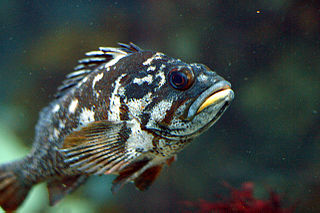
The gopher rockfish, also known as the gopher sea perch, is a species of marine ray-finned fish belonging to the subfamily Sebastinae, the rockfishes, part of the family Scorpaenidae. It is found in the eastern Pacific, primarily off California.

The blue rockfish or blue seaperch, is a species of marine ray-finned fish belonging to the subfamily Sebastinae, the rockfishes, part of the family Scorpaenidae. It is found in the northeastern Pacific Ocean, ranging from northern Baja California to central Oregon.

The China rockfish, the yellowstripe rockfish or yellowspotted rockfish, is a species of marine ray-finned fish belonging to the subfamily Sebastinae, the rockfishes, part of the family Scorpaenidae. It is native to the waters of the Pacific Ocean off western North America.

The canary rockfish, also known as the orange rockfish, is a species of marine ray-finned fish belonging to the subfamily Sebastinae, the rockfishes, part of the family Scorpaenidae. It is native to the waters of the Pacific Ocean off western North America.
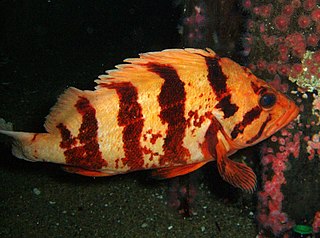
The tiger rockfish, also called tiger seaperch, banded rockfish and black-banded rockfish, is a species of marine ray-finned fish belonging to the subfamily Sebastinae, the rockfishes, part of the family Scorpaenidae. It is native to the waters of the Pacific Ocean off western North America.

The widow rockfish, or brown bomber, is a species of marine ray-finned fish belonging to the subfamily Sebastinae, the rockfishes, part of the family Scorpaenidae. It is found in the northeastern Pacific Ocean.

Sebastes miniatus, the vermilion rockfish, vermilion seaperch, red snapper, red rock cod, and rasher, is a species of marine ray-finned fish belonging to the subfamily Sebastinae, the rockfishes, part of the family Scorpaenidae. It is native to the waters of the Pacific Ocean off western North America from Baja California to Alaska.

The yellowtail rockfish, or yellowtail seaperch, is a species of marine ray-finned fish belonging to the subfamily Sebastinae, the rockfishes, part of the family Scorpaenidae. This species lives mainly off the coast of western North America from California to Alaska.

The black rockfish, also known variously as the black seaperch, black bass, black rock cod, sea bass, black snapper and Pacific Ocean perch, is a species of marine ray-finned fish belonging to the subfamily Sebastinae, the rockfishes, part of the family Scorpaenidae. It is sometimes misidentified as the "red snapper".

The quillback rockfish, also known as the quillback seaperch, is a species of marine ray-finned fish belonging to the subfamily Sebastinae, the rockfishes, part of the family Scorpaenidae. This species primarily dwells in salt water reefs. The average adult weighs 2–7 pounds and may reach 1 m in length. Quillback rockfish are named for the sharp, venomous quills or spines on the dorsal fin. Their mottled orange-brown coloring allows them to blend in with rocky bottom reefs. The quillback rockfish eats mainly crustaceans, but will also eat herring. They are solitary and minimally migratory, but not territorial, and give birth to live young (viviparous). They are a popular sport fish, generally caught in cold water 41–60 m deep, but also to subtidal depths of 275 m.
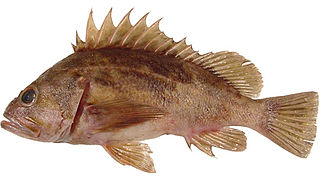
The brown rockfish, whose other names include brown seaperch, chocolate bass, brown bass and brown bomber, is a species of marine ray-finned fish belonging to the subfamily Sebastinae, the rockfishes, part of the family Scorpaenidae. It is found in the northeastern Pacific Ocean.

Sebastes atrovirens, the kelp rockfish, is a species of marine ray-finned fish belonging to the subfamily Sebastinae, the rockfishes, part of the family Scorpaenidae. It is native to the Pacific Ocean along the coast of California in the United States and Baja California in Mexico.

Sebastes glaucus, the gray rockfish or blue rockfish, is a species of marine ray-finned fish belonging to the subfamily Sebastinae, the rockfishes, part of the family Scorpaenidae. This species is found in deep waters of the Northwest Pacific.
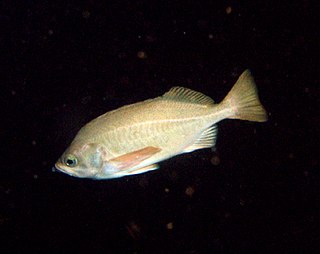
Sebastes ovalis, the speckled rockfish, is a species of marine ray-finned fish belonging to the subfamily Sebastinae, the rockfishes, part of the family Scorpaenidae. It is found in deep rocky areas of the Eastern Pacific.

Sebastes rastrelliger, the grass rockfish, is a species of marine ray-finned fish belonging to the subfamily Sebastinae, the rockfishes, part of the family Scorpaenidae. It is native to the waters of the eastern Pacific Ocean.
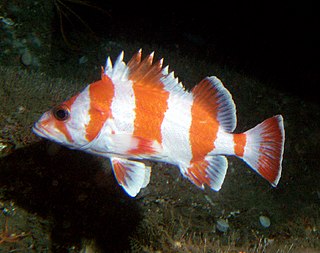
Sebastes rubrivinctus, also known as the flag rockfish, Spanish flag, redbanded rockfish or barberpole, is a species of marine ray-finned fish belonging to the subfamily Sebastinae, the rockfishes, part of the family Scorpaenidae. It is found in the Eastern Pacific.

Sebastes serranoides, the olive rockfish, is a species of marine ray-finned fish belonging to the subfamily Sebastinae, the rockfishes, part of the family Scorpaenidae. It is found in the Eastern Pacific.

Sebastes schlegelii, also known as the Korean rockfish, northern black seaperch, and black rockfish, is a predatory species of marine ray-finned fish belonging to the subfamily Sebastinae, the rockfishes, part of the family Scorpaenidae It is found in the Northwest Pacific Ocean.

Sebastes diaconus, the deacon rockfish, is a species of marine ray-finned fish belonging to the subfamily Sebastinae, the rockfishes, part of the family Scorpaenidae. It is found in the eastern Pacific Ocean.

Sebastes ciliatus, the dusky rockfish, is a species of marine ray-finned fish belonging to the subfamily Sebastinae, the rockfishes, part of the family Scorpaenidae. It is typically found in the North Pacific Ocean, specifically in the Bering Sea near British Columbia, in the Gulf of Alaska, and in the depths of the Aleutian Islands.





















